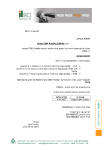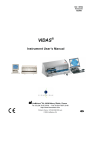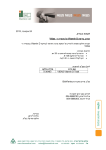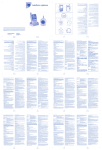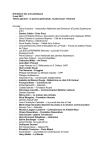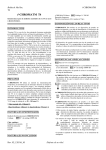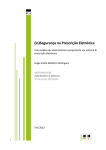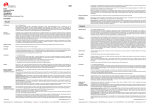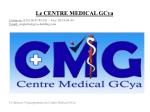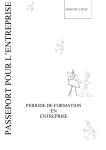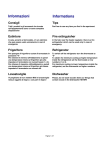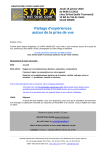Download vidas® ft4 - ILEX Medical Systems
Transcript
12ינואר2012 , לקוחות נכבדים, הנדוןVidas FT4 : חברת אילקס שמחה להודיע על השקת ערכה חדשה לבדיקת (FT4) Free Thyroxinבמכשיר ה.Vidas - יתרונות הערכה: .1הרצת קליברטור בדופליקט במקום טריפליקט. .2טווח מדידה 1-100 pmol/L לתשומת ליבכם ,הקיט הישן לבדיקת ) FT4מק"ט (5-30401ישווק עד סוף שנת .2012 להלן המק"ט החדש להזמנה: שם פריט VIDAS FT4 N 60 TESTS מק"ט אילקס 5-30459 מצ"ב מידע מחברת .BioM’erieux למידע נוסף ניתן לפנות: עילית ליזרמן054-6686183 , אורלי דויטש054-5686303 , בברכה, עילית ליזרמן מנהלת מוצר אילקס מדיקל REF 30 459 9300800 B - en - 2011/10 VIDAS® FT4 (FT4N) VIDAS FT4 is an automated quantitative enzyme immunoassay for use on the instruments of the VIDAS family, for the determination of free thyroxine (FT4) in human serum or plasma (lithium heparin), using the ELFA technique (Enzyme Linked Fluorescent Assay). Measurement of Free Thyroxin is intended for use as an aid in the diagnosis and treatment monitoring of thyroid disorders. SUMMARY AND EXPLANATION From the moment it is secreted into the blood stream, thyroxine or tetraiodothyronine (T4), produced by the thyroid gland, is predominantly (> 99.9%) bound to carrier proteins: TBG (Thyroxine Binding Globulin), TBPA (Thyroxine Binding PreAlbumin), albumin. The fraction that remains free (FT4) is considered as the active part of the hormone (1). The mechanisms regulating thyroid function have a direct effect on the concentration of this free fraction, which explains why it is relatively independent of the concentration of carrier proteins (2-3). In patients with hyperthyroidism, the FT4 concentration increases, whereas in patients with hypothyroidism it generally decreases. Patients on hormone replacement therapy (LT4) may have an elevation of FT4, although clinically they are euthyroid. The VIDAS FT4 test aids in diagnosing thyroid disorders. The FT4 assay must be used in conjunction with other tests, such as TSH, as well as a clinical examination of the patient (4). PRINCIPLE The assay principle combines an enzyme immunoassay competition method with a final fluorescent detection (ELFA). ® The Solid Phase Receptacle (SPR ) serves as the solid phase as well as the pipetting device for the assay. Reagents for the assay are ready-to-use and predispensed in the sealed reagent strips. All of the assay steps are performed automatically by the instrument. The reaction medium is cycled in and out of the SPR several times. The sample is collected and transferred into the well containing an alkaline phosphatase-labeled anti-T4 antibody (conjugate). The antigen present in the sample and the T4 antigen coated on the interior of the SPR compete for the available sites on the specific anti-T4 antibody conjugated to alkaline phosphatase. During the final detection step, the substrate (4-Methyl-umbelliferyl phosphate) is cycled in and out of the SPR. The conjugate enzyme catalyzes the hydrolysis of this substrate into a fluorescent product (4-Methyl-umbelliferone), the fluorescence of which is measured at 450 nm. The intensity of the fluorescence is inversely proportional to the concentration of antigen present in the sample. At the end of the assay, results are automatically calculated by the instrument in relation to the calibration curve stored in memory, and then printed out. CONTENT OF THE KIT (60 TESTS): 60 FT4N Strips 60 FT4N SPRs 2 x 30 STR SPR FT4N Control 1 x 2 mL (liquid) C1 Ready-to-use. Human serum* + L-thyroxine + sodium azide (1 g/L). The confidence interval in pmol/L is indicated on the MLE card after the following mention: "Control C1 Dose Value Range". FT4N Calibrator 1 x 2 mL (liquid) S1 Ready-to-use. Human serum * + sodium azide (1 g/L). The concentration in pmol/L is indicated on the MLE card after the following mention: "Calibrator (S1) Dose Value". The confidence interval in "Relative Fluorescence Value" is indicated on the MLE card after the following mention: "Calibrator (S1) RFV Range". Specifications for the factory master data required to calibrate the test: to read the MLE data, please refer to the User’s Manual. 1 MLE Card (Master Lot Entry) Ready-to-use. Ready-to-use. Interior of SPRs coated with thyroxine. 1 Package Insert provided in the kit or downloadable from www.biomerieux.com/techlib * This product has been tested and shown to be negative for HBs antigen, antibodies to HIV1, HIV2 and HCV. However, since no existing test method can totally guarantee their absence, this product must be treated as potentially infectious. Therefore, usual safety procedures should be observed when handling. The SPR The interior of the SPR is coated during production with thyroxine. Each SPR is identified by the FT4N code. Only remove the required number of SPRs from the pouch and carefully reseal the pouch after opening. bioMérieux SA The Strip The strip consists of 10 wells covered with a labeled foil seal. The label comprises a bar code which mainly indicates the assay code, kit lot number and expiration date. The foil of the first well is perforated to facilitate the introduction of the sample. The last well of each strip is a cuvette in which the fluorimetric reading is performed. The wells in the center section contain the various reagents required for the assay. English - 1 ® VIDAS FT4 9300800 B - en - 2011/10 Description of the FT4N strip Wells Reagents 1 Sample well. 2-3-4 Empty wells. 5 Conjugate: alkaline phosphatase-labeled Methylisothiazolone (MIT) (400 µL). anti-T4 antibody + 1 g/L 6 Wash buffer: Tris-NaCl (0.05 mol/L) pH 7.4 + 1 g/L Methylisothiazolone (MIT) (600 µL). 7 Wash buffer: Tris-Tween, NaCl (0.05 mol/L) pH 7.4 + 1 g/L Methylisothiazolone (MIT) (600 µL). 8 Wash buffer: diethanolamine* (1.1 mol/L or 11.5%) pH 9.8 + 1 g/L sodium azide (600 µL). 9 Empty well. 10 Reading cuvette with substrate: 4-Methyl-umbelliferyl phosphate (0.6 mmol/L) + diethanolamine** (0.62 mol/L or 6.6%, pH 9.2) + 1 g/L sodium azide (300 µL). * HARMFUL reagent: − R 48/22: Harmful: danger of serious damage to health by prolonged exposure if swallowed. − R 41: Risk of serious damage to eyes. − S 26: In case of contact with eyes, rinse immediately with plenty of water and seek medical advice. − S 46: If swallowed, seek medical advice immediately and show this container or label. **IRRITANT reagent: − R 36: Irritating to the eyes. − S 26: In case of contact with eyes, rinse immediately with plenty of water and seek medical advice. For further information, consult the Safety Data Sheet available on request. MATERIALS AND DISPOSABLES REQUIRED BUT NOT PROVIDED − Pipette with disposable tip to dispense 100 µL. − Powderless, disposable gloves. − For other specific materials and disposables, please refer to the Instrument User’s Manual. - VIDAS family of instruments. WARNINGS AND PRECAUTIONS • For in vitro diagnostic use only. • For professional use only. • This kit contains products of human origin. No known analysis method can totally guarantee the absence of transmissible pathogenic agents. It is therefore recommended that these products be treated as potentially infectious, and handled observing the usual safety precautions (see Laboratory biosafety manual - WHO - Geneva latest edition). • This kit contains products of animal origin. Certified knowledge of the origin and/or sanitary state of the animals does not totally guarantee the absence of transmissible pathogenic agents. It is therefore recommended that these products be treated as potentially infectious and handled observing the usual safety precautions (do not ingest or inhale). • Do not use SPRs if the pouch is pierced. • Do not use visibly deteriorated STRs (damaged foil or plastic). bioMérieux SA • Do not use reagents after the expiration date indicated on the label. • Do not mix reagents (or disposables) from different lots. • Use powderless gloves as powder has been reported to cause false results for certain enzyme immunoassay tests. • Kit reagents contain sodium azide which can react with lead or copper plumbing to form explosive metal azides. If any liquid containing sodium azide is disposed of in the plumbing system, drains should be flushed with water to avoid build-up. • The wash buffer in well 8 contains a harmful agent (11.5% diethanolamine). Refer to the risk phrases “R” and precautions “S” above. • The substrate in well 10 contains an irritant agent (6.6% diethanolamine). Refer to the risk phrases “R” and precautions “S” above. • Spills should be wiped up thoroughly after treatment with liquid detergent or a solution of household bleach containing at least 0.5% sodium hypochlorite. See the User's Manual for cleaning spills on or in the instrument. Do not autoclave solutions containing bleach. • The instrument should be regularly cleaned and decontaminated (see the User's Manual). English - 2 ® VIDAS FT4 9300800 B - en - 2011/10 STORAGE CONDITIONS • Store the VIDAS FT4 kit at 2-8°C. • Do not freeze reagents. • Store all unused reagents at 2-8°C. • After opening the kit, check that the SPR pouch is correctly sealed and undamaged. If not, do not use the SPRs. • Carefully reseal the pouch with the desiccant inside after use to maintain stability of the SPRs and return the complete kit to 2-8°C. • If stored according to the recommended conditions, all components are stable until the expiration date indicated on the label. SPECIMENS Specimen type and collection: Human serum or plasma (lithium heparin). Do not use EDTA tubes. Types of tubes validated: − Silicone coated glass tube, − Plastic tube with clot activator, − Plastic tube with clot activator and separation gel, − Plastic tube with lithium heparin, − Plastic tube with lithium heparin and separation gel. Note: Blood sampling tube results may vary from one manufacturer to another depending on the materials and additives used. It is the responsibility of each laboratory to validate the type of sample tube used and to follow the manufacturer’s recommendations for use. Specimen preparation Plain tubes: wait for samples to coagulate and centrifuge according to the tube manufacturer’s recommendations to eliminate fibrin. Other tubes: follow the tube manufacturer’s recommendations for use. Frozen-stored samples: after thawing, all these samples must be homogenized before testing. Mix using a vortex-type mixer. Clarify the samples before by centrifugation, if necessary. Specimen-related interferences None of the following factors have been found to significantly influence this assay: - hemolysis (after spiking samples with hemoglobin, from 0 to 300 µmol/L (monomer)), - lipemia (after spiking samples with lipids, from 0 to 30 g/L equivalent in triglycerides), - bilirubin (after spiking samples with bilirubin, from 0 to 480 µmol/L). However, it is recommended not to use clearly hemolyzed, lipemic or icteric samples and, if possible, to collect a new sample. bioMérieux SA Specimen stability: Samples can be stored at 2-8°C in stoppered tubes for up to 8 days; if longer storage is required, freeze the sera or plasma at -25 ± 6°C. Serum-type samples can be stored for 6 months at -25 ± 6°C, with 4 freeze/thaw cycles. Samples collected in lithium heparin must not be stored for more than 4 months at -25 ± 6°C, with 2 freeze/thaw cycles. INSTRUCTIONS FOR USE For complete instructions, see the User's Manual. VIDAS PTC protocol data entry When using the assay for the first time, and before reading the MLE data, scan the bar code(s) (at the end of the package insert) using the external bar code reader. This reading will allow VIDAS PTC protocol data to be transferred to the instrument software for its update. These data should only be read the first time the assay is used. Master lot data entry Note: When using the assay for the first time, enter the VIDAS PTC protocol (bar codes at the end of the package insert) before reading the MLE data. If the MLE data have been read before the VIDAS PTC protocol data, read the MLE data again. Before each new lot of reagents is used, specifications (or factory master data) must be entered into the instrument using the master lot entry (MLE) data. If this operation is not performed before initiating the tests, the instrument will not be able to print results. The master lot data need only be entered once for each lot. It is possible to enter MLE data manually or automatically using the MLE card. Calibration Calibration, using the calibrator provided in the kit, must be performed each time a new lot of reagents is opened, after the master lot data have been entered. Calibration should then be performed every 14 days. This operation provides instrument-specific calibration information and compensates for possible minor variations in assay signal throughout the shelf-life of the kit. The calibrator, identified by "S1", must be tested in duplicate (see User's Manual). The calibrator value must be within the set RFV "Relative Fluorescence Value" range. If this is not the case, recalibrate. Procedure 1. Only remove the required reagents from the refrigerator. They can be used immediately. 2. Use one "FT4N" strip and one "FT4N" SPR from the kit for each sample, control or calibrator to be tested. Make sure the storage pouch has been carefully resealed after the required SPRs have been removed. 3. The test is identified by the "FT4N" code on the instrument. The calibrator must be identified by "S1", and tested in duplicate. If the control is to be tested, it should be identified by "C1". 4. If necessary, clarify the samples by centrifugation. English - 3 ® VIDAS FT4 9300800 B - en - 2011/10 5. Mix the calibrator, control and samples using a vortex-type mixer (for serum or plasma separated from the pellet). 6. For this test, the calibrator, control, and sample test portion is 100 µL. 7. Insert the "FT4N" SPRs and "FT4N" strips into the instrument. Check to make sure the color labels with the assay code on the SPRs and the Reagent Strips match. 8. Initiate the assay as directed in the User's Manual. All the assay steps are performed automatically by the instrument. 9. Reclose the vials and return them to 2–8°C after pipetting. 10. The assay will be completed within approximately 40 minutes. After the assay is completed, remove the SPRs and strips from the instrument. 11. Dispose of the used SPRs and strips into an appropriate recipient. RESULTS AND INTERPRETATION Once the assay is completed, results are analyzed automatically by the computer. Fluorescence is measured twice in the Reagent Strip’s reading cuvette for each sample tested. The first reading is a background reading of the substrate cuvette before the SPR is introduced into the substrate. The second reading is taken after incubating the substrate with the enzyme remaining on the interior of the SPR. The RFV (Relative Fluorescence Value) is calculated by subtracting the background reading from the final result. This calculation appears on the result sheet. Results are automatically calculated by the instrument using calibration curves stored in memory (4-parameter logistic model) and are expressed in pmol/L. Sera for free hormone assays should not be diluted. The result must be expressed as > 100 pmol/l. VIDAS FT4 assay results should be interpreted as part of a complete clinical evaluation and thyroid function assessment, including at least TSH determination. bioMérieux SA QUALITY CONTROL A control is included in each VIDAS FT4 kit. This control must be performed immediately after opening a new kit to ensure that reagent performance has not been altered. Each calibration must also be checked using this control. The instrument will only be able to check the control value if it is identified by C1. Results cannot be validated if the control value deviates from the expected values. Note It is the responsibility of the user to perform Quality Control in accordance with any local applicable regulations. LIMITATIONS OF THE METHOD • Interference may be encountered with certain sera containing antibodies directed against the reagent components. For this reason, assay results should be interpreted taking into consideration the patient’s history and the results of any other tests performed. • Certain drugs may interfere with free thyroid hormone assays (5, 6, 7). RANGE OF EXPECTED VALUES As a guideline, 95% of the values corresponding to 623 adults who meet the selection criteria for establishing euthyroid status are within the range: 10.6 – 19.4 pmol/L. It is recommended that each laboratory establishes its own reference values from a rigorously selected population (8). English - 4 ® VIDAS FT4 9300800 B - en - 2011/10 PERFORMANCE Studies performed using VIDAS FT4 gave the following results: Measurement range The measurement range of the VIDAS FT4 reagent is from 1 to 100 pmol/L. Detection and quantitation limits The Limit of Detection (LoD) is the concentration of free T4 in a sample that can be distinguished from the blank sample with a probability of 95%. LoD = 0.70 pmol/L. The Limit of Quantitation (LoQ) is the lowest concentration of free T4 that can be quantified with a level of acceptable accuracy and precision. LoQ = 1.11 pmol/L. The study was performed as recommended by the CLSI® document EP17-A. Precision Seven samples were tested in duplicate in 40 different runs (2 runs per day) with 2 reagent lots at 3 sites (n=240). Repeatability (within-run precision), and reproducibilities (within-system within-lot and between-system between-lot) were calculated using this protocol, based on the recommendations of the CLSI® document EP5-A2: Repeatability Sample Within-system within-lot reproducibility Between-system betweenlot reproducibility Mean concentration (pmol/L) Standard deviation CV (%) Standard deviation CV (%) Standard deviation CV (%) Sample 1 4.1 0.25 6.2 0.42 10.3 0.54 13.2 Sample 2 10.21 0.37 3.6 0.67 6.6 0.84 8.3 Sample 3 10.39 0.39 3.8 0.54 5.2 1.35 13.0 Sample 4 19.84 0.61 3.1 0.86 4.3 1.46 7.4 Sample 5 33.15 0.82 2.5 1.18 3.6 1.68 5.1 Sample 6 51.53 1.18 2.3 1.96 3.8 3.02 5.9 Sample 7 74.47 2.25 3.0 2.98 4.0 4.86 6.5 bioMérieux SA English - 5 ® VIDAS FT4 9300800 B - en - 2011/10 Specificity 5. STOCKIGT J. R. - Drug effects on thyroid function. Thyroid international 2 (2000). 6. GRONROOS P. E., IRJALA K. M., SELEN G. P., FORSSTROM J. J. – Computerized monitoring of potentially interfering medication in thyroid function diagnostics. Int J. Clin. Monit. Comput., 1997, 14(4), 255259. 7. Norme CLSI. Measurement of Free Thyroid Hormones: Approved Guideline CA45-A V24 N°31. 8. Laboratory Support for the Diagnosis and Monitoring of Thyroid Disease. Laboratory Medicine Practice Guidelines Editors : L. M. Demers, C. A. Spence, 2002, 1-32. Interference was studied according to recommendations of the CLSI® document EP7-A2. Tested compound No interference observed up to the concentration of: 3,5,-diiodothyrosine 223.6 µg/L 3,5-diiodothyronine 546.2 µg/L L-Triiodothyronine 27.1 µg/L D-thyroxine 2.9 µg/L the INDEX OF SYMBOLS Symbol Comparison with another test method 587 serum samples distributed over the measurement range were assayed simultaneously using the VIDAS FT4 kit and an enzyme immunoassay kit according to ® the recommendations of the CLSI document EP9-A2. The Passing and Bablok line equation obtained is: Y = 1.067 X – 1.123 Correlation coefficient = 0.978 (n = 587) WASTE DISPOSAL Dispose of used or unused reagents as well as any other contaminated disposable materials following procedures for infectious or potentially infectious products. It is the responsibility of each laboratory to handle waste and effluents produced according to their nature and degree of hazardousness and to treat and dispose of them (or have them treated and disposed of) in accordance with any applicable regulations. LITERATURE REFERENCES 1. SAPIN R., D'HERBOMEZ M. - Dosage des hormones thyroïdiennes : thyroxine (T4) et triiodothyronine (T3). In La thyroïde, LECLERE J., ORGIAZZI J., ROUSSET B., SCHLIENGER Elsevier, ed. 2001, 268-274. 2. PEARCE C.J., BYFIELD P.G.H. - Free thyroïd hormone assays and thyroïd function. Ann. Clin. Biochem., 1986, 23, 230-237. 3. EKINS R. - Measurement of Free Hormones in Blood Endocrine Reviews, vol. 11, n°1, 1990, 5-46. 4. CARAYON P., NICCOLI-SIRE P., LEJEUNE P.J., et al. Recommandation de consensus sur le diagnostic et la surveillance des maladies de la glande thyroïde. Ann. Biol. Clin.- mai-juin 2002, vol. 60, n°3. Meaning Catalogue number In Vitro Diagnostic Medical Device Manufacturer Temperature limitation Use by Batch code Consult Instructions for Use Contains sufficient for <n> tests WARRANTY bioMérieux disclaims all warranties, express or implied, including any implied warranties of MERCHANTABILITY AND FITNESS FOR A PARTICULAR USE. bioMérieux shall not be liable for any incidental or consequential damages. IN NO EVENT SHALL BIOMERIEUX’S LIABLITY TO CUSTOMER UNDER ANY CLAIM EXCEED A REFUND OF THE AMOUNT PAID TO BIOMERIEUX FOR THE PRODUCT OR SERVICE WHICH IS THE SUBJECT OF THE CLAIM. BIOMERIEUX, the blue logo, VIDAS and SPR are used, pending, and/or registered trademarks belonging to bioMérieux SA or one of its subsidiaries. CLSI is a trademark belonging to Clinical and Laboratory Standards Institute Inc. Any other name or trademark is the property of its respective owner. bioMérieux SA RCS LYON 673 620 399 69280 Marcy-l'Etoile / France Tel. 33 (0)4 78 87 20 00 Fax 33 (0)4 78 87 20 90 www.biomerieux.com







